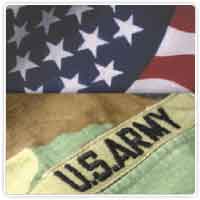How the Military Uses Flags

How the Military Uses Flags
The United States Flag is known as a symbol of freedom and unity in America. Throughout the years, the flag has evolved into the familiar icon that it is today; complete with 13 stripes and 50 stars. Although the American flag is used to represent the history of the country and the fundamentals it was founded upon, there are also a variety of ways that the United States armed forces utilize not only the American flag but other types of flags in order communicate, commemorate, pay their respects to fallen soldiers and much more. These symbols play an important role in a variety of circumstances within the operations of the United States military.
Type of Flags
In 1860, The United States Army Signal Corps was put together under the direction of Albert Meyer who served as the Chief Signal Officer. Meyer understood the significance of communication throughout battle to give commanders and soldiers a way to send signals and orders from a distance. In its early form, this type of communication was referred to as the wig wag system. Using only one flag instead of two, the wig wag used the left, right and forward motions to represent the numbers one, two and three. These numerical combinations could then be translated to convey a message.
These techniques have been utilized by the US since the Civil War to signal a variety of messages. Today, they have evolved into a combination of various flag types and uses. These flags include:
• Garrison Flag: This type of flag is one of the largest American Flags used on special occasions. The US Garrison Flag measures 20 foot hoist by 38 foot fly.
• Post Flag: Traditionally, post flags are used to simply identify a military post and symbolize the location and significance of a location in which the US military has established camp. The US Post Flag measures 8 foot 11 3/8 inches hoist by 17 foot fly.
• Field Flag: The US Field Flag measures 6 foot 8 inches hoist by 12 foot fly and is flown when distinguished guests are present.
• Storm Flag: Like the name indicates, storm flags are hung when there is a storm over the military post. The US storm warning flag measures 5-foot hoist by 9 foot 6 inches fly.
• Internment Flag: Also known as burial flags, these are used to honor and show respect to fallen soldiers and veterans during the funeral. The US Interment Flags measure 5 foot hoist by 9 foot 6 inches fly and are typically made of cotton material.
• Color Flags: Various sectors of the military and their officials are represented by colors that differentiate them from others.
• Distinguished Flags: Used to mark where high ranking officers or military headquarters are located.

Burial Processions
When honoring the life of a veteran, the United States Military uses the American Flag to commemorate and thank individuals for their service. The burial flag is reserved for those who served in at least one enlistment or were granted an honorable discharge from the military.
The flag is placed on the casket of the solider in various positions depending on how the casket is presented. Upon the conclusion on the ceremony, the pallbearers are expected to lift the flag while “Taps” is played to honor the deceased, folded into a triangle and presented to the individual’s family. These flags, used to show honor and respect are an important tradition for military members and their families. Many families purchase flag display cases for displaying the burial flag in memory of their loved ones.
Uniform Patches
The United States Military wears an American Flag patch on their camouflage uniforms as well. In an effort to identify with fellow soldiers, as well as represent the country and citizens they are working to protect and serve, the flag is used as a symbol. While communicating the allegiance of an American soldier, this patch is represented differently than the other ways our military uses flags.
The flag is displayed backwards on the uniform - The explanation is that even these flags should follow the traditional rules of hanging an American flag; the blue section at the highest position of honor and should face towards the front. When placed backwards on the right or left arm of a uniform, there arm acts as a flagpole and if the flag were to be moving when they walked, the red and white stripes would flow to the back, leaving the blue section at the highest point.
A Symbol of Freedom and Strength
The military has a variety of ways to use flags, including the American flag, to communicate with one another, show respect and signify location or rank. Throughout United States history, the flag has continually become a symbol for freedom and strength in America.
All Star Flags has your favorite flag, with the largest assortment of American flags, international, religious, historic and message flags, and so much more! We also have a full line of military flags for sale. They even have you covered with flagpoles and accessories to help you honor the service of those in the military that protect our freedom. Fly your flag proudly today with the help of All Star Flags.
By Chad Creech, All Star Flags
